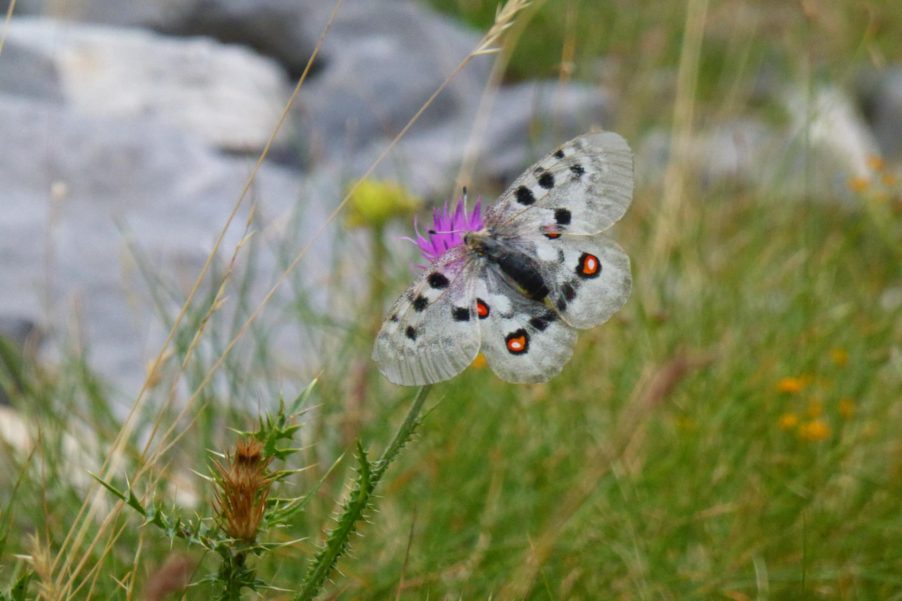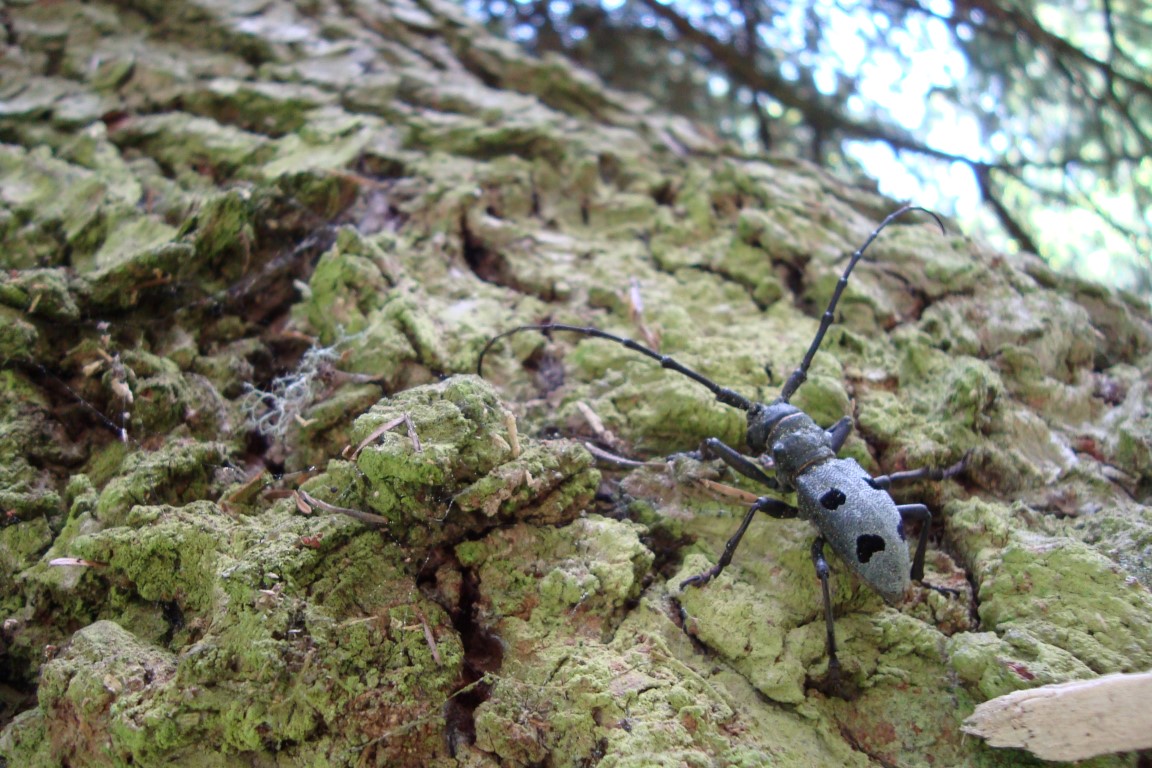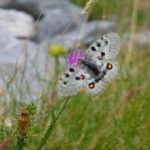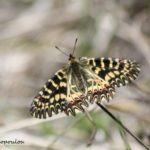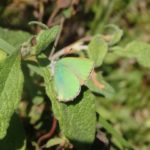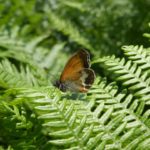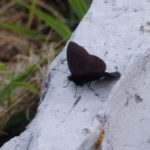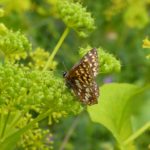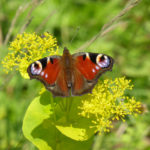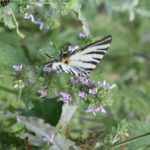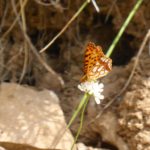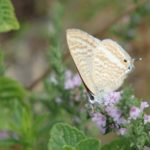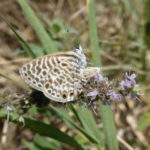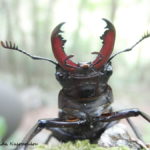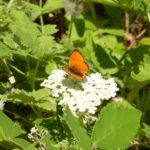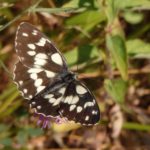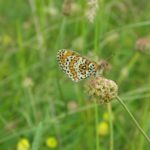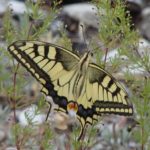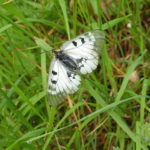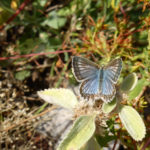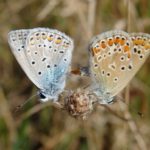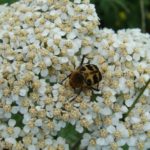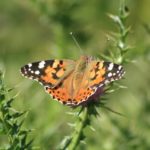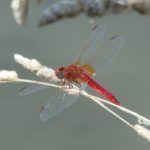Invertebrates
Olympus is a biodiversity hotspot for butterflies in Greece, as approximately 155 species have been recorded to date, from a total of the 23913 Greek species. Moreover, it is a habitat for invertebrates of European Community interest and importance such as: Parnassius apollo, Zerynthia polyxena, Morimus funereus, Lucanus cervus, Cerambyx cerdo, Parnassius mnemosyne and Buprestis splendens.
As invertebrates are among the lesser studied taxa of Olympus, each year new species are recorded through monitoring actions and added to the site’s species list. Indicatively, 275 species of invertebrates were recorded during 2013-2016, out of which 24 species were considered significant or belonged to some kind of protection regime14,7,8. As research progresses in this group, an increase is expected both in the number of total species as well in the number of important species.
Important Invertebrate Species
| Α/Α | SPECIES | PROTECTION STATUS |
|---|---|---|
| 1 | Anax imperator | P.D. 67/198115 |
| 2 | Boloria dia | P.D. 67/1981 |
| 3 | Buprestis splendens | Annex ΙΙ - 92/43/EE |
| 4 | Cerambyx cerdo | Annex ΙΙ - 92/43/EE |
| 5 | Charaxes jasius | P.D. 67/1981 |
| 6 | Erebia melas | P.D. 67/1981 |
| 7 | Erynnis marloyi | Endangered 16 |
| 8 | Gonepteryx rhamni | P.D. 67/1981 |
| 9 | Hemianax ephippiger | P.D. 67/1981 |
| 10 | Lathrobium olympicum | Endemic 14 |
| 11 | Lucanus cervus | Annex ΙΙ - 92/43/EE |
| 12 | Lycaena ottomanus | Endangered 16 |
| 13 | Lycaena thersamon | Endangered 16 |
| 14 | Morimus funereus | Annex ΙΙ 92/43/EE |
| 15 | Muschampia tesselum | P.D. 67/1981 |
| 16 | Parnassius apollo | Annex ΙV - 92/43/ΕE, P.D. 67/1981 |
| 17 | Parnassius mnemosyne | Annex ΙV - 92/43/EE, P.D. 67/1981 |
| 18 | Pieris ergane | P.D. 67/1981 |
| 19 | Plebejus pylaon | Vulnerable 17 |
| 20 | Poecilimon thessalicus | Endemic 1 |
| 21 | Polyommatus ripartii | P.D. 67/1981 |
| 22 | Spialia phlomidis | P.D. 67/1981 |
| 23 | Trichius sexualis | Endangered 18 |
| 24 | Zerynthia polyxena | Annex ΙΙ - 92/43/EE |
a Priority habitats / Species: Natural habitats and species that are in danger of disappearance for the conservation of which the Community has particular responsibility in view of the proportion of their natural range which falls within its territory. They are denoted by an asterisk (*) in Annexes I and II and special measures apply to them.
b Annex I Habitat types of EU Habitat’s Directive 92/43/EEC: Natural habitat types of community interest whose conservation requires the designation of special areas of conservation.
c Annex II Species of EU Habitat’s Directive 92/43/EEC: Animal and plant species of community interest whose conservation requires the designation of special areas of conservation.
d Annex IV Species of EU Habitat’s Directive 92/43/EEC: Animal and plant species of community interest in need of strict protection.
e Annex Ι species of EU Wild Bird’s Directive 2009/147/ΕEC: Species that are subject to special conservation measures concerning their habitat in order to ensure their survival and reproduction in their area of distribution.
1 «Specialized Environmental Study of Olympus National Park» (2010). Ministry of Environment, Energy and Climate Change, Dept. of Environmental Planning, Division for the Management of the Natural Environment.
2 Tsitsoni Th., Fotiadis G., ELKE-AUTH (2015). «Surveillance and evaluation of the conservation status of Habitat Types of European Community Interest in the area of jurisdiction of Olympus National Park Management Agency». Phase D’. ONPMA, RDP Macedonia-Thrace 2007-2013.
3 Council Directive 92/43/EEC “On the Conservation of Natural Habitats and of Wild Fauna and Flora”.
4 Strid, A. (1980). Wild Flowers of Mount Olympus. Goulandri Natural History Museum, Athens.
5 Tsitsoni Th., Fotiadis G., Tsitinis G., ELKE-AUTH (2015). «Surveillance and evaluation of the conservation status of Plant species of European Community Interest in the area of jurisdiction of Olympus National Park Management Agency». Phase D’. ONPMA, RDP Macedonia-Thrace 2007-2013.
6 Sokos, Ch., Birtsas P., Hatzinikos E., Bontzorlos V., Papaspyropoulos, Κ., et al., TECHNOOMOIOSTASI-YLORIKI-LOUVITAKIS (2015). «Surveillance and evaluation of the conservation status of Mammals of European Community Interest in the area of jurisdiction of Olympus National Park Management Agency». Phase D’. ONPMA, RDP Macedonia-Thrace 2007-2013.
7 Olympus National Park Management Agency (2017). Technical Report 2016 on the Monitoring of Environmental Parameters, Litochoro.
8 Olympus National Park Management Agency (2016). Technical Report 2015 on the Monitoring of Environmental Parameters, Litochoro.
9 Legakis, A. & Maragou, P. (2009). The Red Book of Endangered Animals of Greece.Hellenic Zoological Society, Athens.
10 Bousbouras, D. & YETOS Ο.Ε. (2015). «Surveillance and evaluation of the conservation status of Birds of European Community Interest in the area of jurisdiction of Olympus National Park Management Agency». Phase D’. ONPMA, RDP Macedonia-Thrace 2007-2013.
11 Directive 2009/147/EC of the European Parliament and the Council of 30 November 2009 “On the Conservation of Wild Birds”.
12 Ioannidis I., Papamichail G., GEOANALYSIS Α.Ε. (2015) «Surveillance and evaluation of the conservation status of Amphibians & Reptiles of European Community Interest in the area of jurisdiction of Olympus National Park Management Agency». Phase D’. ONPMA, RDP Macedonia-Thrace 2007-2013.
13 Pamperis, L. (2009). The Butterflies of Greece. 2nd edition, PAMPERI & ΚΟΑΝ publishers, Athens. Website www.pamperis.gr for updates on the book.
14 Avtzis D., Kaltsas D., TECHNOOMOIOSTASI-YLORIKI-LOUVITAKIS (2015) «Surveillance and evaluation of the conservation status of Invertebrates of European Community Interest in the area of jurisdiction of Olympus National Park Management Agency». Phase D’. ONPMA, RDP Macedonia-Thrace 2007-2013.
15 Presidential Decree 67/1981 (Hellenic Government Gazette No. 23 Α’/30-1-1981) “On the protection of native flora and wild fauna and the procedures for the coordination and control of their research”.
16 Heath, J. (1981) Threatened Rhopalocera (butterflies) of Europe. Council of Europe.
17 Tolmann, T. & Lewington, R. (2008). Collins Butterfly Guide: The Most Complete Field Guide to the Butterflies of Britain and Europe. 3rd Edition, HarperCollins UK.
18 Speight M.C.D. (1989). Saproxylic invertebrates and their conservation. Council of Europe.

